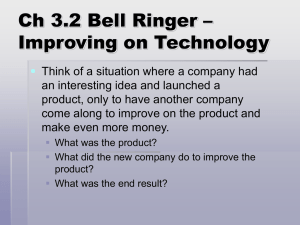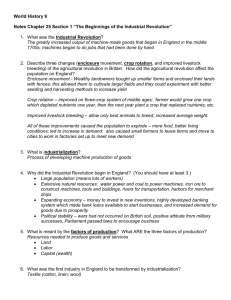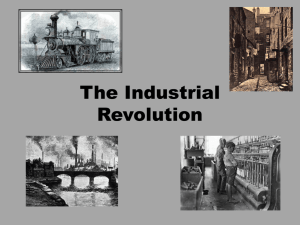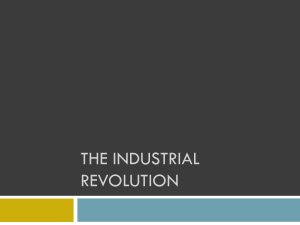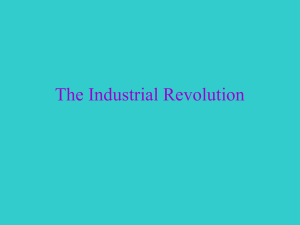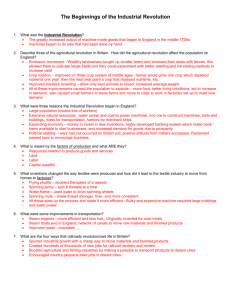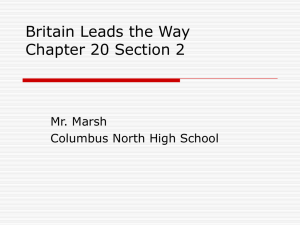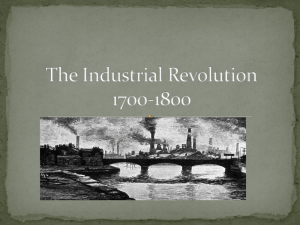Chap_9.1_Beginnings_of_Industrialization_Outline
advertisement
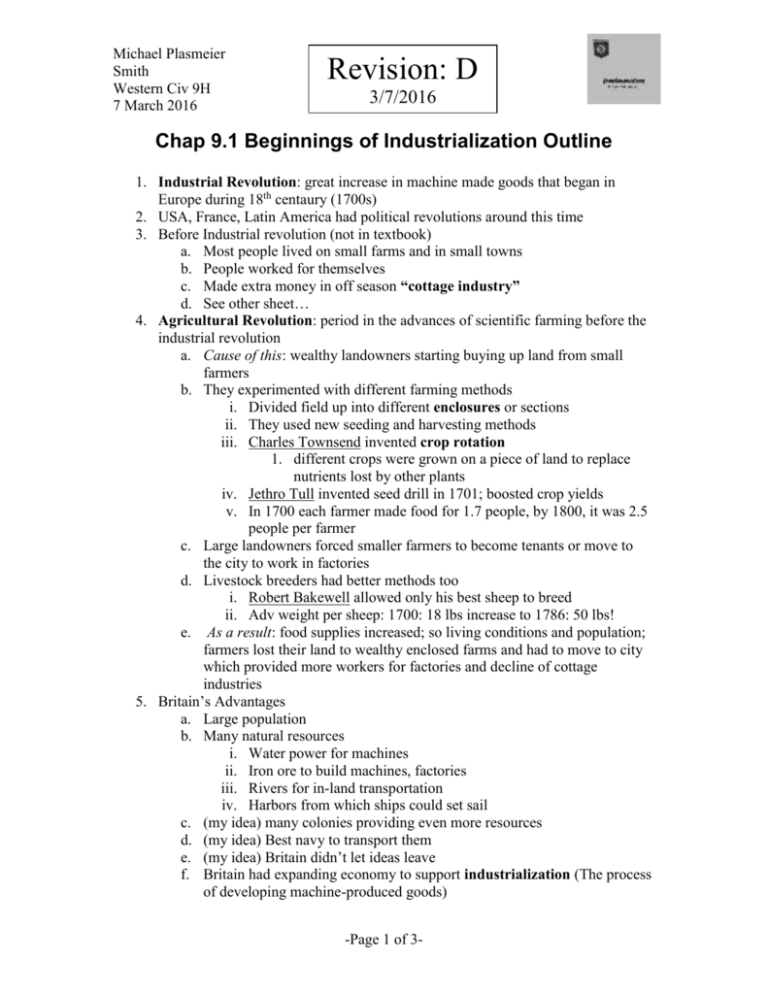
Michael Plasmeier Smith Western Civ 9H 7 March 2016 Revision: D 3/7/2016 Chap 9.1 Beginnings of Industrialization Outline 1. Industrial Revolution: great increase in machine made goods that began in Europe during 18th centaury (1700s) 2. USA, France, Latin America had political revolutions around this time 3. Before Industrial revolution (not in textbook) a. Most people lived on small farms and in small towns b. People worked for themselves c. Made extra money in off season “cottage industry” d. See other sheet… 4. Agricultural Revolution: period in the advances of scientific farming before the industrial revolution a. Cause of this: wealthy landowners starting buying up land from small farmers b. They experimented with different farming methods i. Divided field up into different enclosures or sections ii. They used new seeding and harvesting methods iii. Charles Townsend invented crop rotation 1. different crops were grown on a piece of land to replace nutrients lost by other plants iv. Jethro Tull invented seed drill in 1701; boosted crop yields v. In 1700 each farmer made food for 1.7 people, by 1800, it was 2.5 people per farmer c. Large landowners forced smaller farmers to become tenants or move to the city to work in factories d. Livestock breeders had better methods too i. Robert Bakewell allowed only his best sheep to breed ii. Adv weight per sheep: 1700: 18 lbs increase to 1786: 50 lbs! e. As a result: food supplies increased; so living conditions and population; farmers lost their land to wealthy enclosed farms and had to move to city which provided more workers for factories and decline of cottage industries 5. Britain’s Advantages a. Large population b. Many natural resources i. Water power for machines ii. Iron ore to build machines, factories iii. Rivers for in-land transportation iv. Harbors from which ships could set sail c. (my idea) many colonies providing even more resources d. (my idea) Best navy to transport them e. (my idea) Britain didn’t let ideas leave f. Britain had expanding economy to support industrialization (The process of developing machine-produced goods) -Page 1 of 3- Michael Plasmeier 3/7/2016 Revision: D g. Business people invested in new technologies h. Highly developed banking system played a part i. People were encouraged by the availably of bank loans to invest in machines and expand their operations i. Growing overseas trade j. economic prosperity k. Climate for progress l. Political stability (big advantage!) i. Though Britain was in many wars in 1700s, all were on foreign soil and did not disrupt homeland ii. Military and political success gave Britain a positive attitude iii. Parliament passed laws protecting businesses and helping expansion m. Other countires also had some of these advantages n. Though Britain had all the factors of production (see below) i. Main Idea: Britain had all of the resources needed to produce services and goods that the Industrial Revolution required. These were land, labor, and capital/wealth 6. Inventions Spur Technological Advances a. “In an explosion of creativity, inventions now revolutionized industry.” b. Britain’s textile mills clothed the world in wool, linen, ands cotton. This was the first industry to be transformed. c. Major Inventions in the Textile Industry i. By 1800, several major inventions revolutionized + modernized the textile industry. One Invention led to another. ii. John Kay made a shuttle that helped with making yarn doubled what a person could do in a day, 1733 iii. James Hargreaves invented a spinning wheel; it allowed a worker to spin 8 threads at a time, 1764 iv. Richard Arkwright invented the water frame/water wheel to power the new machines, 1769 v. Samuel Crompton combined the features of the spinning jenny and water frame to make a spinning mule. It made thread that was stronger, finer, and more consistent then older machines, 1779 vi. Edmund Cartwright invented a power loom to speed up the process, 1787 vii. The water frame, spinning mule and power loom were bulky and expensive viii. They took weaving out of the house and into factories, large building owned by wealthy textile merchants ix. Factories were built near water for power and transportation x. England’s cotton came from American south 1. removing seeds was hard till Eli Whitney invented cotton gin, 1793 2. This made cotton production skyrocket 3. 1.5 million pounds in 1790 to 85 million pounds in 1810 -Page 2 of 3- Michael Plasmeier 3/7/2016 Revision: D d. Improvements in Transportation i. Progress in textiles forced progress in other industries ii. A steam engine was needed for cheap, convenient power iii. Early models (1705) took too much fuel and were used in mines iv. James Watt improved it’s efficiency 1. Matthew Boulton, an entrepreneur paid Watt to further develop engine in hopes of making profits off it v. Water Transportation 1. Robert Fulton used a steam engine to power a boat (The Clermont) up and down the Hudson River 2. England built many canals to help with transportation a. By mid-1800s there were 4250 miles of cannel vi. Road Transportation 1. John Mc Adam, puts rocks on road to help with drainage a. Roads could now be traveled when wet 2. Private investors build roads and charged the public to use them (Turnpikes) vii. Railway Age Begins 1. Richard Trevithick build a locomotive based off steam power 2. George Stephenson built the first railroad line a. It went from Yorkshire coalfields to Stockton port b. Used 4 of Stephenson’s locomotives (The Rocket) 3. Liverpool-Manchester Railway a. Used Stephenson’s locomotives (The Rocket) i. It could haul 13 tons at 24 mph b. Opened in 1830; immediate success 4. Railroads revolutionize Europe a. Were a cheaper way to transport goods b. Created hundreds of thousands of jobs c. Boosted agriculture and fishing industries which could now ship goods farther to cities d. Made commuting to the city easy e. Took city dwellers to resorts in country side 7. “Like a locomotive racing across the country, the Industrial Revolution brought rapid and unsettling change to people’s lives. -Page 3 of 3-
